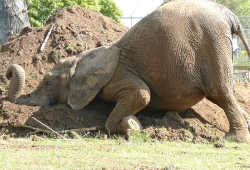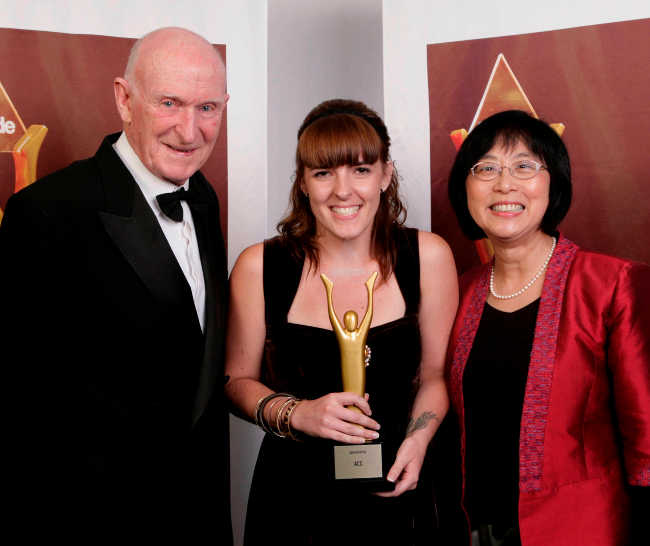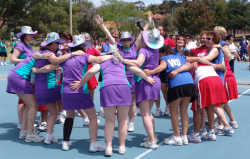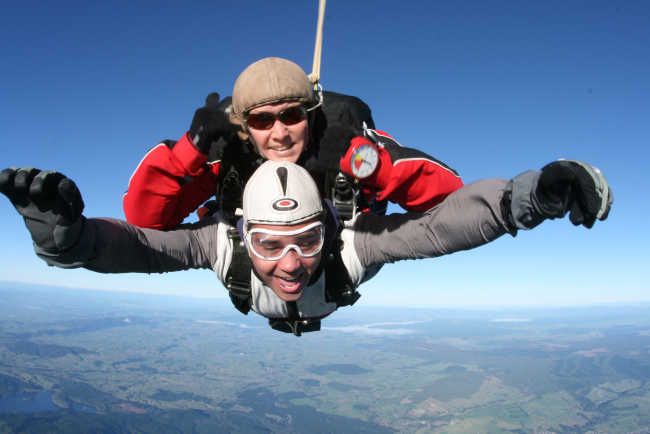Dorothy – 6/2/98
Colin and Jill Clarke gave up their jobs to start a Bed and Breakfast and Guiding business at Lake Rotoiti.
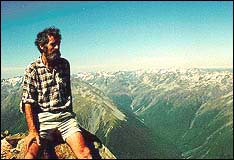
|
| Colin sitting on a rock with a backdrop of mountain country (Click here for a larger version) |
Making the change Three years ago Colin was working at Landcare Research at the University of Canterbury in Christchurch researching animal ecology and biology and animal/plant interactions while Jill ran the office of a furniture factory. Then through a combination of increasing bureaucracy and illness affecting Colin’s work, they felt it was time to move on. They had an opportunity to purchase a near new purpose-built bed and breakfast homestay lodge at St Arnaud, the village beside Lake Rotoiti which is in the Nelson Lakes National Park.
Returning to Colin’s roots For Jill and Colin this was a marked change of lifestyle, but a return to an area they knew well. The lake is close to Tophouse, an area where Colin’s forebears lived. He takes people on tours in the mountain areas he loves and knows so well.
The Herwin family Colin’s maternal great grandfather, Nathaniel Herwin, developed a squatter’s bush block in the Tophouse area in 1872. He did not freehold the block or have it surveyed. A generation later when there was a ballot for property in the area his son, George Herwin, and George’s wife won large areas just below Tophouse and freeholded the property in 1907.
George and his wife had no sons, but two daughters. Their younger daughter Ruth was a great horsewoman and deer shooter, the latter skill being developed to cope with the deer who were competing with the stock for feed.
Ray Clarke Ray was working for the Post and Telegraph Department and was sent to St Arnaud as a postmaster trainee to get practical experience. At that time the roads to St Arnaud and the telegraph system were being developed together.
Then the Depression began and Ray found himself unemployed. He had learnt to shoot deer and he took this up as a full time job, shooting up the Rainbow Valley and selling the skins.
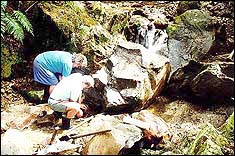 Gold prospecting (Click here for a larger version)
Gold prospecting (Click here for a larger version)In 1928 he married Ruth Herwin. In 1931 he joined a government subsidised gold mining scheme and for six years they lived up the Howard Valley. In later years both used to say that some of their happiest years were spent in this isolated place as there was a wonderful spirit of cooperation and they made great friendships. Colin takes tours for gold prospecting in this area.
The Tophouse Hotel On their return to St Arnaud Ray was asked to look after the Tophouse Hotel for a week. The owner did not return. Ray stayed on to keep the licence and ran the hotel, while Ruth looked after the accommodation, and both managed the farm until 1970.
In 1969 the hotel lost its licence at a time when many old hotels were being closed and their licences were being given to hotels in areas of new city subdivisions. Ray and Ruth retired to St Arnaud.
Colin’s early life While at Tophouse Ruth and Ray had a son, Colin. He began his education by correspondence. Then in 1949 the first teacher came to the new school at St Arnaud, Bill Rowling, later to be Prime Minister of New Zealand, and Colin was one of the first pupils. In his childhood he saw few other children and his dogs were his best friends. Then in 1948 Jill Barnett started coming to St Arnaud.
Hunting Colin started hunting rabbits with dogs from the age of three and moved on to hunting possums. When he was eleven he was given a Long Tom .303 rifle which was almost too heavy for him to hold. After he was sent to board in Nelson and attend Nelson Boys College he organised hunting trips with his friends up in the mountains.
Next he trained pig dogs and went pig hunting for local farmers. He progressed to spotlighting and stalking deer up the St Arnaud Range, Rainbow and in the Howard Valley areas. His mother was his instructor and he shot his first deer with her.
The end of schooling In 1958 with the Hon. Arnold Nordmeyer’s black budget Kiwis cut their expenditure and the Tophouse Hotel lost 58% of its business as the customers cut back their spending. Colin had to leave school. Returning to St Arnaud he went deer culling with some professional hunters whom he met in the bar at the hotel – training which gave him a head start. Then after what he describes as ‘a perfunctory one month course’ at Blue Glen Hunter Training School he became a government culler from 1959 to 1961, hunting in Nelson. Marlborough and Canterbury.
Late in 1961 Colin was transferred to Dip Flat in the Wairau Valley to work as an instructor for up to forty trainees a month, teaching them back-country living, river crossing, stalking, and survival skills including cooking in the back-country.
In 1962 because of his hunting and botanical skills Colin started a new career in research.
Interest in botany Colin followed his father and paternal ancestors in being an enthusiastic amateur botanist. Many amateur and professional botanists who stayed at Tophouse had helped kindle his interest in botany. A leading conservator of forests who stayed at Tophouse when Colin was nine presented him with his first botanical text with the inscription, “Best wishes for your future botanical studies”.
A pioneering animal ecologist invited him to join him as a technician engaged in animal research in the Cupola Basin doing identification of plants and their flowering periods and the effect that deer and chamois had on these plants. After working on this from 1962 to 1967 he began researching the patterns of increase and decline of red deer in the north of the South Island.
Marriage and research work Colin married Jill Barnett who had been a regular visitor to Tophouse and shared his enthusiasm for the place. He worked from a base in Nelson and then Lower Hutt on a study of keas and writing papers on his research into deer.
In 1968 he and Jill shifted to Rangiora just north of Christchurch where Colin worked at the Animal Research Centre which was part of the Forest Service. He did research into deer, chamois and pigs, each for a period of ten years. In 1969 and 1970 he and Jill worked in Switzerland where Colin studied plants in the Swiss Alps. He made further trips to Europe demonstrating his research into chamois and the live capture of these animals. His papers on pig biology and ecology have been published around the world.
In 1990 Colin was recognised as a potential world conservationist. Conservationists in the U.S.A. wanted to see his work with his specially trained dogs which capture pigs live and unharmed. They saw the possibility of his using dogs to live-capture endangered species and helping to control pigs around the world. Because of the quality of the dogs Colin was called to the Philippines for the live capture of an endangered pig species there. His hunting skills have also been used for the control of feral pigs in Hawaii, where he has advised on the use and training of dogs. More recently an assignment took him to the Galapagos Islands for a top level meeting on the development of plans for the eradication of feral goats from islands.
Voluntary work at St Arnaud Because of his concern for the environment and his love of the beech forest and the birds Colin has led a programme for the removal of wasp nests from the beech forest that surrounds many of the houses in the village. Last year this programme resulted in the removal of 600 wasp nests – a wonderful achievement – and very important support for the Department of Conservation’s programme in the National Park. This year, 1998, he received funding support for his control work.
Great training for a guide With this background Colin is the ideal guide for the tours he offers:
- Nature walks around St Arnaud
- Gold prospecting
- 4WD tours of the back country looking at history, natural history and geology
- Alpine fauna and flora tours
- Historical tours
- Bird watching tours
With the alpine flowers in full bloom in January Colin has been taking groups up the mountains over a wide area outside the National Park every day in his 4WD vehicle. This gives everyone, including those who are non-walkers, disabled and elderly the chance of experiencing the alpine environment.
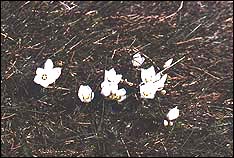
Gentiana bellidifolia (Click here for a larger version)
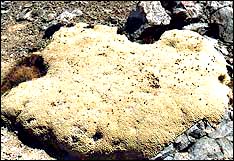
Vegetable Sheep (Click here for a larger version)
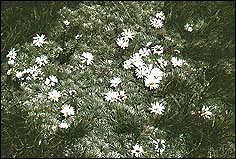
Celmisia sessiliflora (Click here for a larger version)
Visitors from all around the world join the tours. When we last saw Colin he had just returned from taking two Swiss tourists gold prospecting. Markus Spuehler and Daniela Koetting from Zurich, Switzerland, had found enough gold to be made into a wedding ring for their wedding this year!
For more information about these tours and the Homestay go to:
| Colin’s Web site at | – | http://www.ts.co.nz/~c-clarke |
| or email Colin and Jill at | – | c-clarke@st.arnaud.co.nz |
| or write to them at | – | Postal Agency, St Arnaud, Nelson |
| or phone/fax at | – | 64 (0)3 521 1028 |
For further information on the Lake Rotoiti district see: Lake Rotoiti In Nelson Lakes National Park Walking In The Rotoiti Area Of The Nelson Lakes National Park

